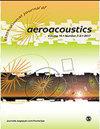Design of a single degree of freedom acoustic liner for a fan noise test rig
IF 1.3
4区 工程技术
Q3 ACOUSTICS
引用次数: 6
Abstract
Acoustic liners are an essential part of noise reduction technologies commonly applied in aircraft turbofan engines. Fan noise suppression can be achieved by selecting an appropriate liner design with optimal acoustic impedance at the blade passing frequency. Great efforts have been made not only to improve experimental characterization and numerical methods for acoustic liners, but also to understand noise generation mechanisms, which ultimately impacts on the liner design itself. To gain confidence in the liner design process, a liner barrel was developed and fabricated for the Fan Noise Test Rig located at the University of São Paulo. To this end, analytical methods were used to determine the optimal acoustic impedance for the Fan Noise Test Rig, and a flat test sample was fabricated for experimental characterization with flow using both in-situ and impedance eduction techniques at the Federal University of Santa Catarina. A liner barrel of same nominal geometry was fabricated and placed at the Fan Noise Test Rig, and a modal decomposition indicated that the Tyler-Sofrin mode has been successfully suppressed at the first blade passing frequency. Numerical predictions of liner transmission loss considering the flat sample impedance showed good agreement with experimental results.风机噪声试验台单自由度声学衬垫的设计
声学衬垫是飞机涡扇发动机降噪技术的重要组成部分。风扇噪声抑制可以通过选择在叶片通过频率下具有最佳声阻抗的适当衬垫设计来实现。人们不仅在改进声学衬垫的实验表征和数值方法方面做出了巨大的努力,而且在理解噪声产生机制方面也做出了巨大努力,而噪声产生机制最终会影响衬垫的设计本身。为了在衬管设计过程中获得信心,为位于圣保罗大学的风机噪声试验台开发并制造了衬管筒。为此,使用分析方法来确定风机噪声测试台的最佳声阻抗,并在圣卡塔琳娜联邦大学使用原位和阻抗喷射技术制作了一个平面测试样品,用于流动的实验表征。制造了一个具有相同标称几何形状的尾管,并将其放置在风机噪声试验台上,模态分解表明,在第一个叶片通过频率下,Tyler Sofrin模式已被成功抑制。考虑平坦样品阻抗的线性传输损耗的数值预测与实验结果吻合良好。
本文章由计算机程序翻译,如有差异,请以英文原文为准。
求助全文
约1分钟内获得全文
求助全文
来源期刊

International Journal of Aeroacoustics
ACOUSTICS-ENGINEERING, AEROSPACE
CiteScore
2.10
自引率
10.00%
发文量
38
审稿时长
>12 weeks
期刊介绍:
International Journal of Aeroacoustics is a peer-reviewed journal publishing developments in all areas of fundamental and applied aeroacoustics. Fundamental topics include advances in understanding aeroacoustics phenomena; applied topics include all aspects of civil and military aircraft, automobile and high speed train aeroacoustics, and the impact of acoustics on structures. As well as original contributions, state of the art reviews and surveys will be published.
Subtopics include, among others, jet mixing noise; screech tones; broadband shock associated noise and methods for suppression; the near-ground acoustic environment of Short Take-Off and Vertical Landing (STOVL) aircraft; weapons bay aeroacoustics, cavity acoustics, closed-loop feedback control of aeroacoustic phenomena; computational aeroacoustics including high fidelity numerical simulations, and analytical acoustics.
 求助内容:
求助内容: 应助结果提醒方式:
应助结果提醒方式:


